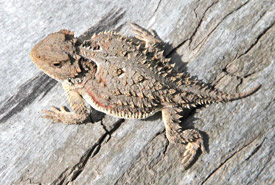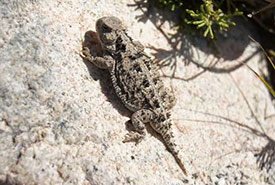
Greater short-horned lizard (Photo by Alan Schmierer)
Greater short-horned lizard
The greater short-horned lizard is the only species of lizard found in Alberta and Saskatchewan. It is sometimes called the “horned toad” because of its squat appearance, although it’s not a toad at all.
What does it look like?
This small lizard is usually less than 10 centimetres in length, with a flat body and short legs. It can be reddish-brown, beige, tan or grey in colour, with dark spots along its back. This colouration, along with the ability to stay very still, allows the greater short-horned lizard to blend in with its environment to ambush prey and avoid predators.
A striking feature of this species is the row of small spines along the back rim of its head. It also has small spines along the side of its body. When threatened, the greater short-horned lizard can inflate its body to appear larger and more bristly.
Where does the species live?
Greater short-horned lizards are found throughout western North America, from Mexico to southern Alberta and Saskatchewan. Canadian populations are scattered and isolated. In Saskatchewan, they are only found in two areas in Grasslands National Park. They are more widespread in Alberta, where populations are found along four main waterways in the southern part of the province.
The habitat of this species ranges from semi-arid plains to high mountains, in open areas with sparse vegetation. It prefers areas with loose, sandy or rocky soil for burrowing underground at night and while hibernating in winter.
What is the species’ conservation status?

Greater short-horned lizard (Photo by Kevin McRae, CC BY-NC 4.0)
The Committee on the Status of Endangered Wildlife in Canada (COSEWIC) designated the species as endangered in 2007. COSEWIC later re-examined and designated the greater short-horned lizard as special concern in 2018. Globally, the International Union for Conservation of Nature has ranked this species as least concern.
The species’ main threats are changes in habitat due to human activities. Other factors include changes in habitat due to invasive plants, as well as summer drought and winter freezing associated with climate change.
What is NCC doing to protect the habitat of this species?
The Nature Conservancy of Canada, with support from the Government of Canada and the North American Waterfowl Management Plan, has secured a key property in Alberta’s Pakowki Lake Natural Area. This property protects habitat for the greater short-horned lizard, as well as other species at risk.



